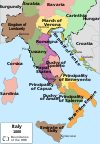King of Italy
This article needs additional citations for verification. (March 2010) |

King of Italy (Latin: Rex Italiae; Italian: Re d'Italia) was the title given to the ruler of the Kingdom of Italy after the fall of the Western Roman Empire. The first to take the title was Odoacer, a "barbarian" military leader, in the late 5th century, followed by the Ostrogothic kings up to the mid-6th century. With the Frankish conquest of Italy in the 8th century, the Carolingians assumed the title, which was maintained by subsequent Holy Roman Emperors throughout the Middle Ages. The last Emperor to claim the title was Charles V in the 16th century. During this period, the holders of the title were crowned with the Iron Crown of Lombardy.
A Kingdom of Italy was restored from 1805 to 1814 with Napoleon as its only king, centered in Northern Italy. It was not until the Italian unification in the 1860s that a Kingdom of Italy covering the entire peninsula was restored. From 1861 the House of Savoy held the title of King of Italy until the last king, Umberto II, was exiled in 1946 when Italy became a republic.
History
After the deposition of the last Western Emperor in 476, Heruli leader Odoacer was appointed Dux Italiae ("Duke of Italy") by the reigning Byzantine Emperor Zeno. Later, the Germanic foederati, the Scirians and the Heruli, as well as a large segment of the Italic Roman army, proclaimed Odoacer Rex Italiae ("King of Italy").[1] In 493, the Ostrogothic king Theoderic the Great killed Odoacer, and set up a new dynasty of kings of Italy. Ostrogothic rule ended when Italy was reconquered by the Byzantine Empire in 552.
In 568, the Lombards entered the peninsula and ventured to recreate a barbarian kingdom in opposition to the Empire, establishing their authority over much of Italy, except the Exarchate of Ravenna and the duchies of Rome, Venetia, Naples and the southernmost portions. In the 8th century, estrangement between the Italians and the Byzantines allowed the Lombards to capture the remaining Roman enclaves in northern Italy. However, in 774, they were defeated by the Franks under Charlemagne, who deposed their king and took up the title "king of the Lombards". After the death of Charles the Fat in 887, Italy fell into instability and a number of kings attempted to establish themselves as independent Italian monarchs. During this period, known as the Feudal Anarchy (888–962), the title Rex Italicorum ("King of the Italians" or "King of the Italics") was introduced. After the breakup of the Frankish empire, Otto I added Italy to the Holy Roman Empire and continued the use of the title Rex Italicorum. The last to use this title was Henry II (1004-1024). Subsequent emperors used the title "King of Italy" until Charles V. At first they were crowned in Pavia, later Milan, and Charles was crowned in Bologna.
In 1805, Napoleon I was crowned with the Iron Crown of Lombardy at the Milan Cathedral. The next year, Holy Roman Emperor Francis II abdicated his imperial title. From the deposition of Napoleon I (1814) until the Italian Unification (1861), there was no Italian monarch claiming the overarching title. The Risorgimento successfully established a dynasty, the House of Savoy, over the whole peninsula, uniting the kingdoms of Sardinia and the Two Sicilies to form the modern Kingdom of Italy. The monarchy was superseded by the Italian Republic, after a constitutional referendum was held on 2 June 1946, after World War II.[2] The Italian monarchy formally ended on 12 June of that year, and Umberto II left the country.
List of kings
As "Rex Italiae"
- Odoacer (476–493)
- vassal of the Eastern Roman Empire.
Ostrogothic Kingdom (493–553)
- Theoderic the Great (493–526)
- Athalaric (526–534)
- Theodahad (534–536)
- Witiges (536–540)
- Ildibad (540–541)
- Eraric (541)
- Totila (541–552)
- Teia (552–553)
Kingdom of the Lombards (568–814)
- Alboin (568–572)
- Cleph (572–574)
- Rule of the dukes (ten-year interregnum)
- Authari (584–590)
- Agilulf (591–c. 616)
- Adaloald (c. 616–c. 626)
- Arioald (c. 626–636)
- Rothari (636–652)
- Rodoald (652–653)
- Aripert I (653–661)
- Perctarit and Godepert (661–662)
- Grimoald (662–671)
- Perctarit (671–688), restored from exile
- Alahis (688–689), rebel
- Cunincpert (688–700)
- Liutpert (700–701)
- Raginpert (701)
- Aripert II (701–712)
- Ansprand (712)
- Liutprand (712–744)
- Hildeprand (744)
- Ratchis (744–749)
- Aistulf (749–756)
- Desiderius (756–774)
- Charlemagne (774–814)
Kingdom of Italy (781–963)
Carolingian Dynasty (781–888)
- Pippin (781–810)
- Bernard (810–818)
- Louis I (818–822)
- Lothair I (822–855)
- Louis II (844–875)
- Charles II the Bald (875–877)
- Carloman (877–879)
- Charles the Fat (879–887)
Instability (888–962)
After 887, Italy fell into instability, with many rulers claiming the kingship simultaneously:
- Berengar I (888–896)
- vassal of the German King Arnulf of Carinthia, reduced to Friuli 889-894, deposed by Arnulf in 896.
- Guy of Spoleto (889–894)
- opponent of Berengar, ruled most of Italy but was deposed by Arnulf.
- Lambert of Spoleto (891–896)
- subking of his father Guy before 894, reduced to Spoleto 894–895.
- Arnulf of Carinthia (894–899)[3]
- Ratold (sub-king 896)
In 896, Arnulf and Ratold lost control of Italy, which was divided between Berengar and Lambert:
- Berengar I (896–924)
- seized Lambert's portion upon the latter's death in 898.
- Lambert of Italy (896–898)
- Louis III of Provence (900-905)
- opposed Berengar 900-902 and 905.
- Rudolph II of Burgundy (922–933)
- defeated Berengar but fled Italy in 926.
- Hugh of Arles (926–947)
- elected by Berengar's partisans in 925, resigned to Provence after 945.
- Lothair II (945–950)
- Berengar II of Ivrea (950–961)
- jointly with his son:
- Adalbert of Italy (950–963)
In 951 Otto I of Germany invaded Italy and was crowned with the Iron Crown of Lombardy. In 952, Berengar and Adalbert became his vassals but remained Kings until being deposed by Otto.
Holy Roman Emperors also crowned "King of Italy" (962–1556)
Ottonian dynasty (962–1024)
| Image | Name | Life | Coronation | Ceased to be King |
|---|---|---|---|---|
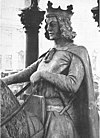 |
Otto I | 23 November 912 - 7 May 973 |
962[4] | 7 May 973 |
 |
Otto II | 955 - 7 December 983 |
c. October 980[5] | 7 December 983 |
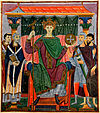 |
Otto III | 980 - 23 January 1002 |
c. February 996[6] | 23 January 1002 |
 |
Arduin I of Ivrea | 955 - 1015 |
1002[4] | 1014 |
 |
Henry II [7] |
6 May 973 - 13 July 1024 |
1004[4] | 13 July 1024 |
Salian dynasty (1027–1125)
| Image | Name | Life | Coronation | Ceased to be King |
|---|---|---|---|---|
 |
Conrad II [8] |
990 - 4 June 1039 |
1026[4] | 4 June 1039 |
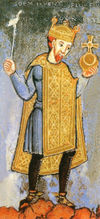 |
Henry III | 29 October 1017 - 5 October 1056 |
1039[4] | 5 October 1056 |
 |
Henry IV | 11 November 1050 - 7 August 1106 |
1056[4] | December 1105 |
 |
Conrad II of Italy | 1074 - 1101 |
1093[4] | 1101 |
 |
Henry V [9] |
8 November 1086 - 23 May 1125 |
1106[4] | 23 May 1125 |
Süpplingenburg dynasty (1125–1137)
| Image | Name | Life | Coronation | Ceased to be King |
|---|---|---|---|---|
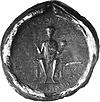 |
Lothair III (or II) | 9 June 1075 - 4 December 1137 |
1125[4] | 4 December 1137 |
Hauteville dynasty (1130–1154)
Roger II used the title King of Sicily and Italy until at least 1135; later he used only the title King of Sicily, Apulia and Calabria. Although his realm included the southern Italian mainland, he never exerted any control over the official Kingdom of Italy, and none of his successors claimed the title King of Italy.
| Image | Name | Life | Coronation | Ceased to be King |
|---|---|---|---|---|
 |
Roger II | 22 December 1095 - 26 February 1154 |
25 December 1130 | 26 February 1154 |
House of Hohenstaufen (1128–1197)
| Image | Coat of Arms | Name | Life | Coronation | Ceased to be King |
|---|---|---|---|---|---|
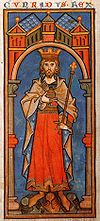 |
 |
Conrad III | 1093 - 15 February 1152 |
1138[4] (Also crowned in 1128 in opposition to Lothair[10]) |
1152 |
 |
 |
Frederick I | 1122 - 10 June 1190 |
1154 | 1186 |
 |
 |
Henry VI | November 1165 - 28 September 1197 |
1186[4] | 28 September 1197 |
House of Welf (1208–1212)
| Image | Coat of Arms | Name | Life | Coronation | Ceased to be King |
|---|---|---|---|---|---|
 |
 |
Otto IV | 1175 or 1176 - 19 May 1218 |
1209[4] | 1212 |
House of Hohenstaufen (1212–1254)
| Image | Coat of Arms | Name | Life | Coronation | Ceased to be King |
|---|---|---|---|---|---|
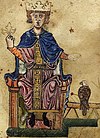 |
 |
Frederick II (Friedrich II) |
26 December 1194 – 13 December 1250 | 5 December 1212 | 13 December 1250 |
 |
 |
Henry (Heinrich (VII)) |
1211 – 12 February 1242 | 23 April 1220 | 12 February 1242 |
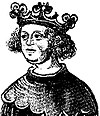 |
 |
Conrad IV (Konrad IV) |
25 April 1228 – 21 May 1254 | May 1237 | 21 May 1254 |
House of Luxembourg (1311–1313)
| Image | Coat of Arms | Name | Life | Coronation | Ceased to be King |
|---|---|---|---|---|---|
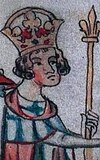 |
 |
Henry VII | 1275[11] - 24 August 1313 |
6 January 1311[12] | 24 August 1313 |
House of Wittelsbach (1327–1347)
| Image | Coat of Arms | Name | Life | Coronation | Ceased to be King |
|---|---|---|---|---|---|
 |
 |
Louis IV | 1 April 1282 - 11 October 1347 |
1327 | 11 October 1347 |
House of Luxembourg (1355–1437)
| Image | Coat of Arms | Name | Life | Coronation | Ceased to be King |
|---|---|---|---|---|---|
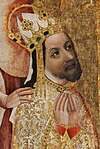 |
 |
Charles IV | 14 May 1316 - 29 November 1378 |
1355[4] | 29 November 1378 |
 |
 |
Sigismund | 14 February 1368 - 9 December 1437 |
1431[4] | 9 December 1437 |
House of Habsburg (1437–1556)
| Image | Coat of Arms | Name | Life | Coronation | Ceased to be King |
|---|---|---|---|---|---|
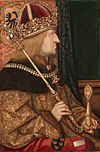 |
 |
Frederick III | 21 September 1415 - 19 August 1493 |
16 March 1452 | 19 August 1493 |
 |
 |
Charles V | 24 February 1500 - 21 September 1558 |
24 February 1530[13] | 16 January 1556 |
Charles V was the last emperor to be crowned king of Italy, or to use the title.[4] The Peace of Westphalia, in 1648, formally ended the rule of the Holy Roman Emperors in Italy. However, the empire continued to include some territory in northern Italy, including Tyrol, until its dissolution in 1806.
Kingdom of Italy (1805–1814), House of Bonaparte
| Image | Coat of Arms | Name | Life | Coronation | Ceased to be King |
|---|---|---|---|---|---|
 |
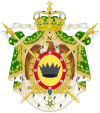 |
Napoleon I | 15 August 1769 - 5 May 1821 |
17 March 1805 | 11 April 1814 |
Full title
This title is present on Italian laws proclaimed by Napoleon I:
[Name], by the Grace of God and the Constitutions, Emperor of the French and King of Italy.
Kingdom of Italy (1861–1946), House of Savoy
| Image | Coat of Arms | Name | Life | Became King | Ceased to be King |
|---|---|---|---|---|---|
 |
 |
Victor Emmanuel II | 14 March 1820 - 9 January 1878 |
17 March 1861 | 9 January 1878 |
 |
 |
Umberto I | 14 March 1844 - 29 July 1900 |
9 January 1878 | 29 July 1900 |
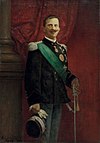 |
 |
Victor Emmanuel III | 11 November 1869 - 28 December 1947 |
29 July 1900 | 9 May 1946 |
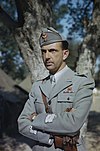 |
 |
Umberto II | 15 September 1904 - 18 March 1983 |
9 May 1946 | 12 June 1946 |
Full title
Up until the dissolution of the monarchy in 1946, full title of the Kings of Kingdom of Italy (1861–1946) was:
[Name], by the Grace of God and the will of the Nation, King of Italy, King of Sardinia, Cyprus, Jerusalem, Armenia, Duke of Savoy, count of Maurienne, Marquis (of the Holy Roman Empire) in Italy; Prince of Piedmont, Carignano, Oneglia, Poirino, Trino; Prince and Perpetual Vicar of the Holy Roman Empire; Prince of Carmagnola, Montmellian with Arbin and Francin, Prince bailiff of the Duchy of Aosta, Prince of Chieri, Dronero, Crescentino, Riva di Chieri and Banna, Busca, Bene, Bra, Duke of Genoa, Monferrat, Aosta, Duke of Chablais, Genevois, Duke of Piacenza, Marquis of Saluzzo (Saluces), Ivrea, Susa, of Maro, Oristano, Cesana, Savona, Tarantasia, Borgomanero and Cureggio, Caselle, Rivoli, Pianezza, Govone, Salussola, Racconigi over Tegerone, Migliabruna and Motturone, Cavallermaggiore, Marene, Modane and Lanslebourg, Livorno Ferraris, Santhià, Agliè, Centallo and Demonte, Desana, Ghemme, Vigone, Count of Barge, Villafranca, Ginevra, Nizza, Tenda, Romont, Asti, Alessandria, of Goceano, Novara, Tortona, Bobbio, Soissons, Sant'Antioco, Pollenzo, Roccabruna, Tricerro, Bairo, Ozegna, delle Apertole, Baron of Vaud and of Faucigni, Lord of Vercelli, Pinerolo, of Lomellina, of Valle Sesia, of the Marquisate of Ceva, Overlord of Monaco, Roccabruna and eleven-twelfths of Menton, Noble Patrician of Venice, Patrician of Ferrara.
See also
- Kings of Jerusalem
- List of kings of the Lombards
- List of monarchs of Naples
- List of monarchs of Sardinia
- List of monarchs of Sicily
- List of monarchs of the Armenian Kingdom of Cilicia
- List of monarchs of the Two Sicilies
- List of rulers of Tuscany
- List of popes
- List of viceroys of Naples
- List of viceroys of Sicily
- List of Italian queens
Notes
- ^ Bury, History, vol. 1 p. 406
- ^ Nohlen, D & Stöver, P (2010) Elections in Europe: A data handbook, p1047 ISBN 978-3-8329-5609-7
- ^ Bryce, James The Holy Roman Empire (1913), pg. xxxv
- ^ a b c d e f g h i j k l m n o Lodovico Antonio Muratori, Giuseppe Oggeri Vincenti, Annali d'Italia, 1788, pp. 78-81.
- ^ According to Sismondi, History of the Italian Republics in the Middle Ages (pg. 29), although Otto II was crowned King of the Romans in 961 and Holy Roman Emperor in 967, he only obtained the Iron Crown at Pavia in late 980, during his descent into Italy, and prior to his celebrating Christmas at Ravenna.
- ^ Although Otto III was crowned Holy Roman Emperor at Rome on 21 May 996, he was crowned King of Italy at Milan prior to the death of Pope John XV in early March 996 - see Comyn, History of the Western Empire, Vol. 1, pg. 123
- ^ enumerated as successor of Henry I who was German King 919–936 but not Emperor.
- ^ enumerated as successor of Conrad I who was German King 911–918 but not Emperor
- ^ Barraclough, Geoffrey (1984). The Origins of Modern Germany. W. W. Norton & Company. ISBN 0-393-30153-2.
- ^ Comyn, Robert. History of the Western Empire, from its Restoration by Charlemagne to the Accession of Charles V, Vol. I. 1851, p. 191.
- ^ Kleinhenz, Christopher, Medieval Italy: an encyclopedia, Volume 1, Routledge, 2004, pg. 494
- ^ Jones, Michael, The New Cambridge Medieval History, Vol. VI: c. 1300-c. 1415, Cambridge University Press, 2000, pg. 533
- ^ Philip Pandely Argenti, Chius Vincta, 1941, p. xvii.

